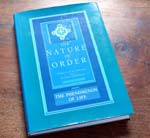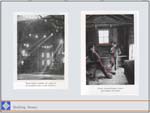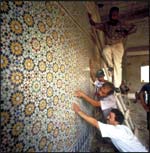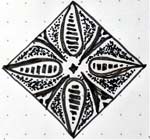
|

|
|
Home Site Search Contact Us Subscribe
|
|
Nature of Order #1: Christopher Alexander's work and its importance in shaping a healthy, living world There is an undercurrent of the idea that architecture, when carried out with processes that Alexander presents in "The Nature of Order," can indeed lead to a more whole and humane society. By Dave Hora October 29, 2020 Editor’s note: With this essay, ArchNewsNow begins an important educational series for architects and students. The Building Beauty Post-Graduate Diploma in Architecture is allowing free access to its weekly webinar on The Nature of Order, Christopher Alexander's seminal book series. Following the sessions, Dave Hora will prepare a series of essays, to be published here on a periodic basis. Together, this material forms the core of an innovative course on the design theories of architect and computer software pioneer Alexander. The series is edited by Nikos A. Salingaros, who worked closely with Alexander.
Author Dave Hora is an expert in Cognitive Science, Design Research, and Human-Computer Interaction. He is associated with The Building Beauty Post-Graduate Diploma in Architecture, and is based in Porto, Portugal. He consults as an independent design researcher and strategist at davesresearch.com
The Broad Arc of Alexander’s Thought(A recount of Building Beauty Program Director Yodan Rofè's introduction to the The Nature of Order reading seminar)
Beneath all of Christopher Alexander’s work is a characterization of architecture and the built environment as a complex whole; the need for anything we create to be as free as possible from internal conflict, tension, contradiction.
It’s all responding to a core line of questioning: “Why does the modern environment fail? Why don’t we – why can’t we – make places that feel beautiful and alive anymore? How do we do it?” We can see Alexander’s work as three major attempts to answer these questions.
The First Answer – “Notes on the Synthesis of Form”Alexander wrote Notes in 1964, about the same time that Jane Jacobs wrote The Death and Life of Great American Cities, which dealt with the same issues. Here, Alexander works within a classical scientific and mathematical framework – the answer is that we do not have a good fit between form and context; we are not appropriately accounting for all of the various forces and needs at play, understanding their dependencies and relationships, and creating goodness-of-fit. He does not yet define positive, extrinsic criteria for quality. (Later, Alexander recants some of the rigorously mathematical thinking, both in the introduction to “Notes,” and in the paper “A City is Not a Tree” [tree in the mathematical sense].)
The Second Answer – PatternsPublished about 15 years later, in development from around 1965 onwards, this answer comes in two major parts, as The Timeless Way of Building (the theory) and A Pattern Language (the practice). The former discusses the philosophical drive that created the beautiful cities of old and some of the reasons we’ve lost the ability to do that. The latter created a new method for transmitting the type of information anyone would need to build healthy environments.
These books are framed in much more of a social and political context than Notes. It is here that we first see the idea of a positive, objective quality we can use to judge the success of building projects; a quality that’s evident in the type of places where people can feel comfortable, can feel at ease with themselves, can feel somehow more alive – the Quality Without a Name. The patterns in A Pattern Language all intend to help its users recognize the human forces that interplay with built structure, to make healthy decisions in the building process that will draw out this Quality. We find a new and continual insistence that peoples’ own deep feeling – not architecture magazines, not glossy photos, not the theory behind the building, but how specific buildings and environments really make us feel – is the core criterion that should be used to judge architecture.
Alexander felt that this did provide a useful answer to the question, but also fell short in practical application, in the real results obtained when others used these methods. He recognized two major problems. First, in the nature of our development processes that could not allow people to build toward Quality in an iterative, adaptive way (the necessary way, the timeless way of doing so before we forgot). And second, that he was formulating concepts that didn’t make sense in the traditional framework of science. And so, even in the 1980s, three decades before it would be published, Alexander was working on the next answer.
The Third Answer – The Nature of OrderA four-volume whole, The Nature of Order is perhaps the most “complete” answer to the core questions behind the work. Ultimately, it offers a new understanding of what is meant by life, order, and space itself. Instead of the Quality from patterns, we see a new framework of terms, which can be used interchangeably: wholeness, things being whole in the sense of blemish or without problems; life, as in degrees of having life and being whole; and most simply, beauty.
Alexander realized that this core of what is important to us in the built world – life of structure, human feeling – cannot truly be discussed in the standard mechanical-reductionist scientific framework, so he extended it to create a unifying theory of architecture and life. Life, Wholeness, Centers: The driving question(Adapted from Yodan Rofè's introduction)
The first chapter of The Nature of Order, Book 1, cuts to the heart of the problem, “Why is modern architecture failing us?” Alexander answers that it fails because our conception of order – based on the success of the scientific method in explaining the mechanical aspects of the world – develops models that describe the world in mechanistic terms. And that we as a society are really beginning to believe that “this is it,” that this mechanistic view is really all there is to the world – that any value must then come subjectively from us, and is not intrinsic to the system. Therefore we have no guide, no basis, and no common ground for producing a living world.
We need real scientific progress to understand order as it really is, including these things we can objectively feel as aspects of actual reality. And the basis for that new conception of order is in life, wholeness, and centers.
The idea of LifeAlexander’s conception of life recognizes that the bifurcation of “society” and “nature” is no longer sustainable, and rescues the term from the realm of pure biology. He offers a view on life that is both intuitive and clearly felt by each of us – think of the places and the situations where you would consider yourself to “feel alive” to understand this.
This idea of life is not limited to activities and situations, but is produced by the structure of [some section] of the world around us. That is, in this sense, one building can be more alive than another. A sidewalk of stones with little bits of moss growing between them can be more alive than poured concrete. It’s quite likely the table produced by a master carpenter will have more life than the table assembled from an Ikea flat pack. This is essentially important: This life has a direct bearing on our own feeling, on our personal wellbeing, and on the wellbeing of the environment around us.
WholenessThat “environment around us” is really just one thing – the concept behind “wholeness” is that everything, the whole universe, everything in it, is one unbroken wholeness. Alexander extends this concept, and instantiates the idea of wholeness as a structure, call it W if you like, the real and unbroken fabric or substrate in which everything exists. (For a physics-theoretical discussion of wholeness, David Bohm’s work on the implicate order might be a good place to start.)
This means that in every situation of our lives, if we are working on building a bench, building a window, sitting in front of our computer screen, walking a path in the park, there is always a particular concept of wholeness that we are working (or walking) within. And from this wholeness – in and of this wholeness – centers arise.
CentersA difficult concept. Centers are overlapping, interlocking, contained by, and containing other centers. Contrary to how we’re used to thinking about “things,” centers are not objects. Objects themselves may be centers and can include many centers, but centers are not necessarily objects. A window, a sunbeam, an open hand, the space between two bodies, the curve underneath a doorway arch…
Centers can be centers of attention: things that gain your attention by way of their relationship to other centers. From a logical standpoint, the relationships of centers within wholeness are related to other centers, recursive.
An example: The human head is a center. Each eye, on its own, is a center. The mouth, alone, of course, is a center. The nose, a center. And so on. The face – the configuration of eyes, nose, mouth, other features – is a center defined by the centers that contain it, the centers that it contains, and most importantly, the relationships between all of those centers and how they enhance or strengthen each other center in this area of wholeness. (There’s so much to say, let’s leave off on explication for now; later, when we learn to see in centers and apply them as operational units in the process of building, remarkable things occur.)
In some section of wholeness (perhaps the project at hand, including its site, features of the land, existing buildings, the life and activity that [will] take place there, the character of its sunlight, etc.) we can define and describe that wholeness, the field of centers at play. Alexander outlines 15 properties of geometric structure that can be used to understand the life in wholeness. When these properties are at play, at least one, usually a number of them working together, the field of centers becomes stronger, the wholeness becomes more unified. More bold. More beautiful. More alive.
And a very particular jump, next. When the wholeness has more life, it becomes more Self-life. More like us, more a picture of our own deep self. And when it does so, it makes us more whole: this, specifically, is what we are reacting to, what we feel deeply, in whole and healthy environments. When we are within a good field of centers, we are a part of that good field of centers, and we ourselves are more whole. This is the foundation of a new conception of order that allows for the reality of feeling.
The 15 properties help life manifest from space, and are tools we can use to understand how we ourselves create life, beauty, and wholeness in the world. Nikos Salingaros has said that “making wholeness heals the maker?”
A Provocative Question(Selected commentary from the discussion in the first Nature of Order reading seminar)
Question: “Does the idea of centers and wholeness include humans, social interactions, and if we’re living in harmony or disharmony? Does it mean good building solves our problems, social injustices?”
● Point: given some of Alexander’s own examples in human activity, we can and should feel that we ourselves and our interactions are all in the purview of this worldview. ● Note: this question gets to the core of Alexander’s project, quite quickly. He is pointing out that this is part of the whole, the whole planet as one organism. Many of us see this intuitively, Alexander is working to do this objectively. Essentially, he is bringing back this human element that modernism has rejected.
But, are we talking about drawing a full morality from this worldview? The question gets extended even more deeply: What is our and architecture’s obligation to respond to racism, classism, violence, and the problems of our time?
● Assertion: The world is not made for us, it’s not made according to our social rules. It’s not always beautiful, cozy, or comfortable in the banal sense of the world. Where we have influence on the structure of some area of the world, we can and should work to heal that place. In the full series of The Nature of Order, we don’t find what you might describe as a full basis for morality. ● Perspective, from Salingaros, a close collaborator of Alexander’s:
“[Alexander] does not offer an answer to the problems of the world – because of his honesty. He does not make big claims to promote himself. But at the same time, you see the answer indirectly in some of the work he’s done and in The Nature of Order from his actions. The level of care and attention that you see in his social housing projects, in his design, and his care for the individual – the proof is there in how he acts. He cuts through the hypocrisy of the totalitarian top-down method that does not bother to see what the user’s life is like. (And this causes a hell of a row in architecture school…)”
● Point: We can carry out our ideals through the projects we take on and how we work on them. ● Personal reflection: This connects some prior lines of thought for me: It’s not necessarily the remit of architecture to solve these problems, nor is it in the field of architecture that these problems are created. But we do see the same forces that create our societal problems instantiated in architecture – the sterile ideals of high modernism are exactly what Alexander is fighting against as they are being built into the world around us. If his approach to adaptive living processes works for creating more healthy structure in the built world, perhaps it’s a similar approach we need in how we develop policy, law, organization…
The discussion seems to take as a given that human activity – social, political, other types of action – are fully contained with the ideas of centers and wholeness, within the realm of thought that Alexander presents in this first reading.
There is an undercurrent of the idea that architecture, when carried out with processes that Alexander presents in The Nature of Order, can indeed lead to a more whole and humane society. I think this is in line with the ideals that drive some of the first and broad-scope patterns in A Pattern Language.
Closing: What Guides the Work
From Yodan Rofè: “I think for you now, taking this course, it’s actually a lot more important not to worry so much about what others think – but to be as true as possible to what you feel. Not what you think, but deeply feel. To develop your own feeling, and develop your own sense of that feeling. To know better when you feel well. And it’s not obvious when you really feel well.
“Exercise this judgment: Try to
understand, feel, sense the different places you inhabit. Understand how one
place feels versus another. This is the tool you will use in your productive
life. It may be different from what other people think, but it’s really
important for you to know what you feel. “If there’s anything I’ve learned from Alexander, it’s that he was always searching for what he was feeling. Not taking it for granted, always questioning if he was right, exploring alternatives: What was it that would give just a bit more of that sense of feeling?”
Dave Hora is an expert in Cognitive Science, Design Research, and Human-Computer Interaction. He is associated with The Building Beauty Post-Graduate Diploma in Architecture, and is based in Porto, Portugal. He consults as an independent design researcher and strategist at davesresearch.com
Image #4 from a lecture for Building Beauty by Chris Andrews: “Tiles in Architecture: A taste of the tremendous potential of color & ornament in buildings”: https://www.buildingbeauty.org/resource-center-entries/2018/01/28/tiles-in-architecture
|
(click on pictures to enlarge)  Dave Hora "The Nature of Order, Book 1: The Phenomenon of Life" by Christopher Alexander  Dave Hora In Book 1, Alexander discusses the idea of "life" as it occurs in human activities and the structure of space in the built environment.  Yodan Rofe / Building Beauty course The Building Beauty seminar discusses Alexander's notion of overlapping and interlocked "centers" in space - not necessarily objects, but centers of attention.  Peter Sanders/Saudi Aramco World/PADIA There is joy in creating things and places of beauty (image from Building Beauty lecture by Chris Andrews: "Tiles in Architecture").  Dave Hora A pattern |
© 2020 ArchNewsNow.com